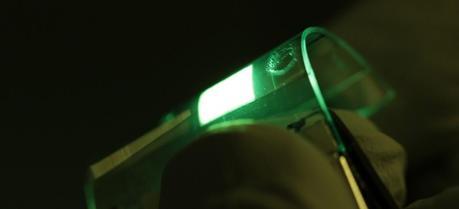 OLED emit homogeneous planar light and may be applied to flexible carrier materials. (Photo: Ralph Eckstein)
OLED emit homogeneous planar light and may be applied to flexible carrier materials. (Photo: Ralph Eckstein)The “cyFLEX” project is aimed at adapting materials for organic light-emitting diodes (OLED) to printing and coating processes. This OLED printing technology can be used in future production of luminous packaging, labels, and billboards.
An OLED (organic light-emitting diode) is a light-emitting diode (LED) in which the emissive electroluminescent layer is a film of organic compound which emits light in response to an electric current. This layer of organic semiconductor is situated between two electrodes. Generally, at least one of these electrodes is transparent. OLEDs are used to create digital displays in devices such as television screens, computer monitors, portable systems such as mobile phones, handheld games consoles and PDAs. A major area of research is the development of white OLED devices for use in solid-state lighting applications. There are two main families of OLED: those based on small molecules and those employing polymers.
Compared to polymer OLEDs, OLEDs based on low-molecular compounds, so-called small molecules, are characterized by higher energy efficiencies, better qualities, and longer service lives. However, production of small-molecule OLEDs has been based nearly exclusively on material-consuming vacuum evaporation of expensive metal complexes so far. An inexpensive OLED printing technology can therefore make a real difference in the field.
“To produce high-quality OLED at competitive costs, low-cost metal-organic molecules have to be developed and adapted to appropriate printing and coating processes,” Dr. Norman Mechau, Head of the working group at the Light Technology Institute of KIT, explains.
For this purpose, the cyFLEX joint project was launched: cynora GmbH developed optoelectronic emitter materials based on copper metal that is inexpensive and highly available. Under cyFLEX, these patented materials will be modified specifically. Dissolution, viscosity, wetting, and layer formation properties will be varied such that the materials are converted into liquid formulations and may be applied in the form of homogeneous thin films for use in printing and coating processes suited for mass production.
Under cyFLEX, the consortium of cynora, KIT’s LTI, and the InnovationLab (iL) GmbH research and transfer platform adapts copper-based emitter materials to printing and coating processes, develops OLED inks, and studies aspects of liquid processing and large-area printing. It is planned to produce a printed flexible OLED foil in a small series. Potential packaging with luminous and animated images, logos, and texts might open up new product marketing options in the future. “For example, light effects may start when a customer approaches a product in order to attract attention,” Dr. Norman Mechau says.
The project is carried out by the Light Technology Institute (LTI) of KIT in cooperation with cynora GmbH and covers the complete chain of values added from the material to the component. The project has just started with a total funding volume of €576,000 ($767980) and will run two years.

